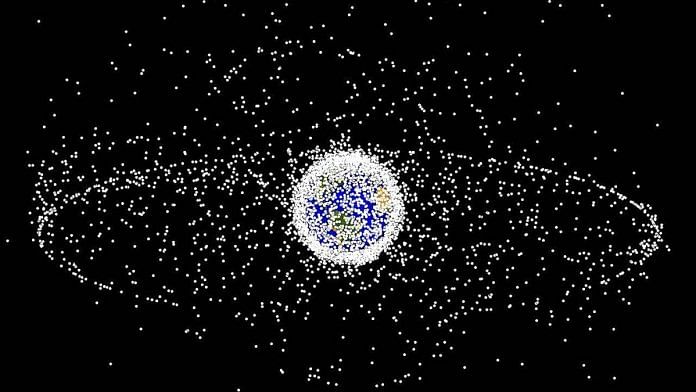Bengaluru: The Russian military conducted an anti-satellite test (ASAT) this week, shooting down one of its own satellites in low Earth orbit. The test was likely conducted with a missile launch on 13 or 14 November, and the satellite broke up on 15 November when trackable debris started to appear in orbit.
More than 1,500 large pieces of trackable debris were generated from the explosion of the satellite, as well as potentially hundreds or thousands of untrackable smaller pieces, according to the US government.
The satellite that was blown up was the Kosmos 1408, a defunct Soviet-era ELINT (Electronic and Signals Intelligence) satellite that was launched in 1982. It had an approximate mass of 1,750 kg.
The satellite was in orbit just above the ISS at 480km, and the space station passed through the debris field every 93 minutes, putting the astronauts and cosmonauts stationed there in danger, and drawing flak from American space agency NASA. Chinese taikonauts at the country’s under-construction space station Tiangong-3 were also put in danger.
The missile used was likely an A-235 PL-19 Nudol anti-ballistic anti-satellite weapon, launched from the Plesetsk Cosmodrone, which is located 800 kilometers north of Moscow. The missile is capable of operating at long-range (1,500 km), medium range (1,000 km), and short range (350 km). It was designed to shield Moscow from a nuclear attack.
Also read: What is the cryogenic upper stage that led to failure of ISRO’s earth observation satellite
Danger to ISS & Chinese space station
There were seven astronauts aboard the International Space Station (ISS) at the time when the satellite was shot down — three American, one French, and one Japanese astronauts, and two Russian cosmonauts. They were asked by NASA to take refuge in their docked spacecraft capsules for two hours as a precaution, to prepare for a quick emergency exit from the station if required, the American space agency said in a statement.
After the third pass of the ISS through the debris, NASA deemed it safe for the astronauts to return inside the ISS.
The test also endangered the Chinese space station Tiangong-3 that is currently being assembled in orbit, and is holding three Chinese taikonauts. No details have been released about the precautionary measures taken by the Chinese taikonauts.
“With its long and storied history in human spaceflight, it is unthinkable that Russia would endanger not only the American and international partner astronauts on the ISS, but also their own cosmonauts. Their actions are reckless and dangerous, threatening as well the Chinese space station and the taikonauts on board,” said NASA Administrator Bill Nelson.
The Russian space agency Roscosmos said in a tweet that the debris has moved away from the ISS and the station is “in the green zone”.
The @Space_Station crew is routinely performing operations according to the flight program.
The orbit of the object, which forced the crew today to move into spacecraft according to standard procedures, has moved away from the ISS orbit.
The station is in the green zone. pic.twitter.com/MVHVACSpmT
— РОСКОСМОС (@roscosmos) November 15, 2021
Previous ASAT tests
In the 1960s and 1970s, during the Cold War, the Soviet Union conducted a series of ASAT tests, declaring them a success.
Since the end of the Cold War, this is the fourth ASAT test conducted in space by any country with missiles launched from Earth.
India was the most recent, conducting an ASAT test under Mission Shakti in 2019, shooting down MicroSat-R, a low-cost DRDO satellite. Over 400 pieces of trackable debris were generated, and put ISS potentially at risk, but most burned up in the atmosphere within a few weeks.
In 2007, China conducted a similar test blowing up a satellite at a much higher orbit, with it breaking up into over 35,000 pieces, with debris spreading across the entire width of low Earth orbit — from 200km to 3,850 km altitude. This test too put at risk the astronauts who were aboard the ISS at the time, including Indian-American Sunita Williams.
In 2009, the US conducted Operation Burnt Frost, where a defunct satellite was hit at a height of 220km, generating hundreds of pieces of debris. Most of it burned up in the atmosphere, but some were blown into higher orbits and remained there for over 18 months.
Space debris can build up exponentially in a cascading process called Kessler’s Syndrome, where a piece of debris hits another satellite, which in turn creates thousands of more pieces of debris.
Legal question-marks
Anti-satellite tests are considered a form of military technology, equipped to shoot down intelligence satellites, and their use is not covered by international laws. It is a matter of contention whether ASAT tests violate the Outer Space Treaty of 1967.
Article 9 of the treaty states that all space activities are to be guided by the principle of cooperation and mutual assistance, with regard to interests of all parties of the treaty. The treaty also forbids weapons of mass destruction and nuclear warheads in outer space, but does not explicitly prohibit conventional weaponry.
This week’s test follows closely on the heels of increased tensions between the US and Russia, with US officials publicly warning Europe about Russia’s increasing military presence at Ukraine’s borders.
(Edited by Poulomi Banerjee)
Also read: European satellites could help catch the next climate change disaster



